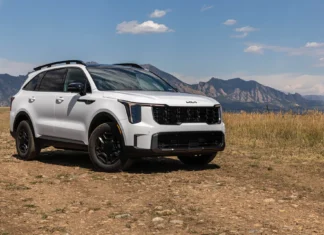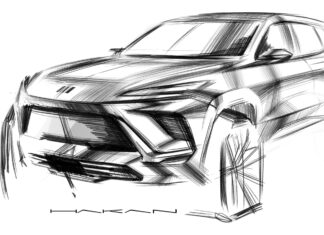
Kona, Hawaii – If you happened to be a fan of the expensive limited production Lexus LFA supercar, then you’re going to love the new 2018 Lexus LC 500 series International Grand Touring Sport Coupes, which are based on the LF-LC concept car. There will be two versions – the LC 500 powered by a V8 engine, and the LC 500h, a V6 powered Hybrid, and both are based on a new GA-L platform architecture. The base MSRP for the Lexus LC 500 is $92,000., while the sticker for the Lexus LC 500h starts at $96,510. Destination and handling for each is $995. Okay, that’s still expensive, but certainly more reasonable than the going rate for the LFA.

Propulsion for the Lexus LC 500 is drawn from a 5.0-liter, DOHC, 32-valve, normally aspirated, Dual VVT-I and EFI/D-4S longitudinally front mounted V8 engine that generates 471 horsepower at 7,100 rpm while also developing 396 pound feet of torque at 4,800 rpm. EPA mileage estimates are 16-mpg city/ 26-mpg highway and 19 mpg combined.

Powering the Lexus LC 500h is a Series/parallel system with gas engine and electric Motors. The gas engine is a 3.5-liter, DOHC, 24-valve V6 with VVT-iW, EFI and D- 4S – also longitudinally mounted up front, that produces 295 horses at 6,500 rpm along with 256.7 pound feet of torque at 4,900 rpm. The electric power comes from two Water-cooled Permanent magnet synchronous motors: MG-1- functions as Primary generator, engine starter and controls engine speed; MG-2 – Drives the rear wheels and provides regenerative braking.
Total system power – 354 horsepower. Electricity is generated by an 84 cell Lithium Battery Pack – 310.8 V nominal voltage / 650 V System voltage. LC 500h EPA mileage estimates are 26-mpg city / 35-mpg highway and 30 mpg combined.
The transmission for the LC500 is a Ten-speed Sport Direct Shift automatic with steering wheel mounted magnesium paddle shifters and manual mode. The LC500h gears energy to the driving wheels via a Multi Stage Hybrid Transmission (another name for CVT). There is a Torsen® high-capacity, torque-sensing Limited Slip Differential.

Visually, the Lexus LC 500 and the Lexus LC 500h share the same design and styling cues, the only difference being the specific Hybrid badging. The Hybrid even carries the split rectangular dual exhaust tips. The overall design is boldly expressive and is literally drop dead gorgeous from virtually every viewing angle. It might well be referred to as seductively wrapped technology.

Up front is the traditional Lexus Spindle grille, but in a modified and enhanced form that blends with the dramatically sculpted hood, and is flanked by the Polaric Ellipsoid System compact lens LED 3-projector headlamps and lower air intakes. The grille features a progressively graduated mesh pattern, enlarged from top to bottom, with a bright surround trim without a top bar, and the headlamp assemblies form light rows that point to the grille.

In profile, the LC500 displays short front and rear overhangs and a roofline that appears to float free from the body, which sits low over the wheels. Both the shoulder and rocker lines sweep gracefully inward, reminiscent of early Coke bottles.


In the rear, the bold new three-dimensional tail lamps accentuate the car’s low and wide stance, flowing around to the sides. There is an integrated spoiler lip just ahead of an active rear spoiler.

Inside the cabin is a cockpit-like driver zone with dual “Oh s—t” grab handles for the front passenger for stabilization during spirited maneuvers. Controls and switchgear are optimally placed for ease of use. Even the non-sport seats are highly supportive and comfortable, and the driver’s seating position is ideally located to achieve a properly centered operational point.

In terms of body rigidity, the new LC 500 serves up the stiffest Lexus built to date, including the LFA.
Several performance enhancement Packages are available as are a host of stand alone optional features. Connectivity and Infotainment are provided through Lexus Enform.

Takumi (translated as Master) craftsmanship is evident through out both new Lexus LC 500s.

During the national press launch program, I was afforded the opportunity to pilot first an LC500 V8, followed by an LC 500h over selected drive loops on the big island. The LC 500 wore an Infrared metallic exterior and featured a Black interior, and the LC 500h sported a Sonic Titanium exterior and Black interior. Both vehicles were preproduction units and as a result had no official Monroneys for final pricing. The LC 500 came to an estimated total of $99,995 after adding known Package pricing and Destination charges. The LC 500h had an estimated total of $97,905. No pricing was available for some Packages or some stand- alone optional features and equipment. Both LC 500 series vehicles could possibly exceed the $100,000. mark depending upon options and packages chosen. Optional equipment on the base LC 500 and LC500h models includes 20” and 2”forgedalloy wheels, a Mark Levinson audio System, Limited Slip Differential, Blind Spot Monitor, Intuitive Park Assist, Head-Up-Display, and a Cold Area Package that includes a heated steering wheel and windshield de-icer. The list of equipment and features that come as standard is considerable, but too lengthy to include here.
SUMMARY: As already stated, the 2018 Lexus LC 500 and 2018 Lexus LC 500h are both flagship status 2+2 performance coupes that share the same GL-A global platform architecture as well as the same stunningly beautiful, futuristic design appeal – the only differences being a subtle variance in badging.

In terms of the performance attributes, the V8 power of the LC 500, unquestionably moves it to the top rung of the performance ladder, although, it‘s only three tenths of a second quicker from 0-60 mph than its LC 500h hybrid stable mate, and its top speed capability is only 13 mph faster. Despite these factors, many colleagues found the performance of the LC 500h to be inferior – an analysis that I personally don’t agree with. I do feel however, that the extra cost of the hybrid may be difficult to justify. The top speed on the big island is 55 mph, which I’m sure was exceeded on more than one occasion by more than one participating journalist. Hey, both cars just want to go fast. And utilizing the paddle shifters on the LC 500 delivers a pleasingly raucous note, blipping the throttle during downshifts, when set in the sport + setting of the Drive mode Select knob.
The interior ambience showcases not only a smoothly flowing elegance, but delivers a comfortable and most supportive ride quality during highly spirited maneuvers. Despite its 2+2 designation, don’t plan lounging leisurely in the minimal rear seat, especially behind tall front seat occupants.
The driving dynamics are superb, providing a solid, planted feel, with spot-on steering responsiveness and road-holding grip. The Active Rear Steering is effective and comes as part of the $10,000 Sport Performance Package with Carbon that also includes a Variable Gear Ratio System, an Active Rear Spoiler, Alcantara headliner and Carbon Fiber scuff plates.

In the bottom line analysis, the 2018 model Lexus LC 500 and LC 500h 2+2 performance sport coupes provide entry into an exclusive class of luxury super sports cars, which are slated to go on sale in May when they first arrive in dealerships. Buyers will then be able to “Experience Amazing” enveloped in seductive technology – that according to Lexus insiders. Kudos to Toyota/Lexus chief Akio Toyoda for his meaningful vision and guidance in this super car to fruition.
SPECIFICATIONS: 2018 Lexus LC 500 and Lexus LC 500h
Base Price: $92,000. – LC 500 / $96,510. – LC 500h
Price as Tested: $99,995. – LC500 / $97,905. -LC 500h
Engine Type and Size: LC500 – 5.0-liter, DOHC, 32-valve, Dual VVT-I and EFI/D-4S
Horsepower (bhp): 471 @ 7,100 rpm
Torque (ft./ lbs.): 396 @ 4,800 rpm
Engine Type and Size: LC 500h Series/parallel system with gas engine and electric motors.
3.5-liter, DOHC, 24-valve V6 with VVT-iW, EFI and D-4S
Horsepower (bhp): 295 @ 6,600 rpm
Torque (ft./ lbs.): 256.7 @ 4,900 rpm
Total system power – 354 horsepower.
Water-cooled Permanent magnet synchronous motors.
MG-1- Primary generator, engine starter, controls engine speed.
MG-2 – Drives rear wheels; regenerative braking.
Lithium Battery Pack / 84 cells- 310.8 V nominal voltage / 650 V System voltage.
Transmission: LC500-Ten-speed Sport Direct Shift automatic with
paddle shifters and manual mode.
LC500h – Multi Stage Hybrid Transmission.
Drive Train: Longitudinally mounted front engine / Rear-Wheel Drive with available Limited Slip Differential.
Suspension: Front – Multi-link.
Rear – Multi-Link
Brakes: Power-assisted four-wheel vented disc brakes with Anti-lock Braking System, Electronic Brake force Distribution and Brake Assist
Tires: Michelin 245/45 RF20 front / 275/40 RF20 rear – 0ptional 245/40 RF 21 front / 275/35 RF21 mounted on 5-“V”–spoke alloy wheels.
Wheelbase: 113.0 inches
Length Overall: 187.4 inches
Width: 75.6 inches – w/o mirrors.
Height: 53.0 inches – unloaded.
Curb Weight: 4,280 lbs. –LC500 / 4,435 lbs – LC 500h
Turning Circle: 17.7 ft. (17.4 w/Active Rear Steering).
Fuel Capacity: 21.7 gallons- LC500 / 22.2 gallons – LC500h
EPA Mileage Estimates: 16 mpg city / 26 mpg highway
Drag Coefficient: 0.33
0 – 60 mph: LC500-4.4 seconds –Top track speed 168 mph
LC500h-4.7 seconds – 155 mph top speed.
• Styling – 5 Stars
• Performance – 5 Stars
• Ride and Handling – 5 Stars
• Utility – 5 Stars
• Comfort and Convenience – 5 Stars
• Economy – 4.5 Stars
• Value and Competition – 4 Stars
SUMMARY – 4.78 Stars
The 2018 Lexus LC500 is a stunning example of a 2+2 Luxury Sport Coupe. Everything about it is first rate except perhaps the fuel economy, which the LC 500h makes up for, but it seems overpriced when compared to the 500C.

























































